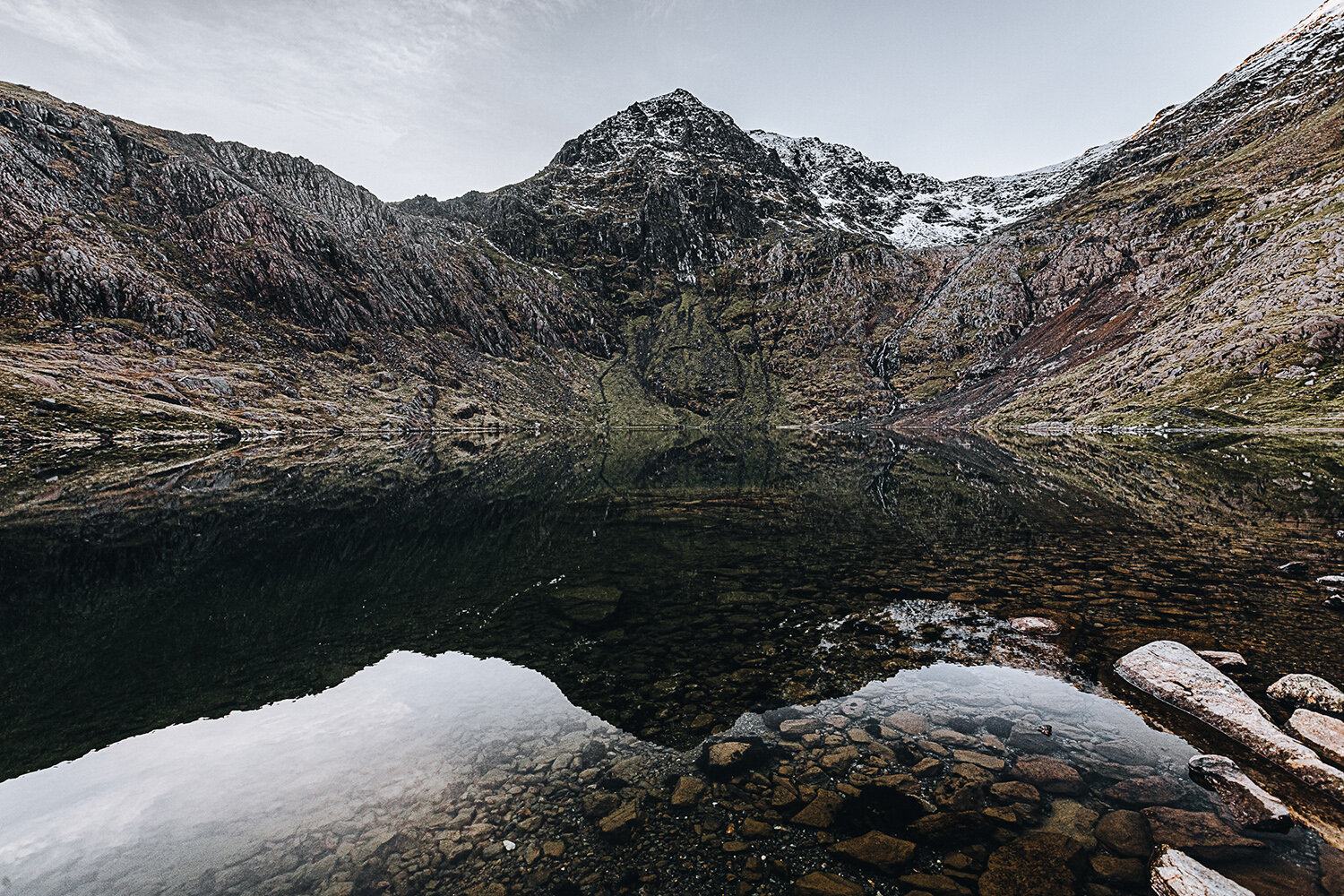Celebrating the UK's National Parks
HOW THEY CAME TO BE & WHY WE SHOULD TREASURE THEM
IF WE CAN SAY ONE THING ABOUT 2020, IT IS THAT IT SHONE A LIGHT ON HOW IMPORTANT KEEPING ACTIVE AND SPENDING TIME OUTDOORS IS FOR US. THE BLANKET REASON OF ‘TO KEEP FIT’ HAS FINALLY BEEN DIVERSIFIED, AND WE UNDERSTAND THAT KEEPING PHYSICALLY HEALTHY GOES HAND IN HAND WITH HOW WE CARE FOR OUR MENTAL WELL BEING.
A 2018 study carried out by the University of East Anglia found that “People living closer to nature also had reduced diastolic blood pressure, heart rate and stress. Exposure to greenspace significantly reduces people's levels of salivary cortisol - a physiological marker of stress.”. With reportedly 11.7 million ‘working days’ lost annually in the UK due to stress, depression & anxiety, it seems more important than ever to spread the word about the benefits of getting a little lost in nature.
Did you know that the UK has 15 National Parks?
They cover 8,748 square miles – almost 10% of England and 20% of Wales, though less of Scotland (just over 7%). Spread fairly evenly across the island, this ensures that most of us live within an hour of at least one area of iconic natural beauty.
Crib Goch, Snowdonia, Wales
A path to Striding Edge, The Lake District
One of my first memories is of my younger sister, aged just 2 or 3 flopping into a wetland bog whilst marvelling at a cluster of wild ponies in the New Forest; a National Park (since 2005) we were lucky enough to spend a precious few formative years growing up in. Since then, we’ve spent wonderfully wet weekends camping in the Brecon Beacons, enjoyed a sunset chip-shop and stove-pot baked bean dinner on the sunset drenched hills in Dartmoor, and memorably, created the ‘Clifford route’ up to Snowdon summit after losing the Watkin Path during driving rain and fog.
These, and many other such unforgettable experiences, have influenced me strongly and it’s all thanks to the benefits of being able to visit such stunningly beautiful National Parks.
2021 sees the 70th anniversaries of the first 4 National Parks, and more people than ever are visiting them. In a report by Julian Glover (Landscapes Review) more than 19 million people visited the Lake District and 13 million flocked to the Peaks in 2019. 70 years down the line though, and we’re starting to see some problems. Glover’s report calls for us to ‘reignite the founding spirit in which they were created’. What’s needed is a better balance between people and nature, which essentially boils down to: we need to take more care. 2020 saw an astronomic increase in people lacing up new walking boots and heading out to the hills, which in itself is fantastic news, but in the wake of which follows endless grim news reports filled with images of countryside scenes plastered in litter and overflowing car parks.
We need to take care that what we loved about them most isn’t lost.
So get out and explore our beautiful wild spaces, but do it mindfully, with respect to the landscape so that it may continue to be enjoyed for another 70 years and more.
Above Kinder Downfall, The Peak District
The Waterfalls at Ystradfellte, The Brecon Beacons, Wales
INTERESTED IN HOW OUR NATIONAL PARKS CAME INTO BEING?
THE STORY OF THE CREATION OF THE UK’S NATIONAL PARKS SPANS TWO CENTURIES WITH CONTRASTING UNDERCURRENTS OF ROMANCE AND UPRISING, ALONGSIDE THE GROWING RECOGNITION OF THE SIGNIFICANCE OF THE GREAT-OUTDOORS.
The UK was a bit slow on the uptake really, when it came to establishing areas of land where anyone could wander and explore. The US established its first National Park - Yellowstone, 12 years before the first ‘freedom to roam’ bill went to parliament in 1884. This bill failed, but the campaign, which was to last for more than 60 years, had begun.
It wasn’t until the early 19th century that the public’s mindset began to shift, from seeing the countryside as wild, uncivilised and unsafe, to appreciating its beauty and understanding its need for protection. Great poets and writers of the time, such as Byron, Coleridge and Wordsworth encouraged these values. In his Guide to the Lakes (expanded edition, 1835) Wordsworth claimed Cumbria as "a sort of national property, in which every man has a right and interest who has an eye to perceive and a heart to enjoy".
Growing industrialisation was beginning to open people’s eyes to the importance of open-air recreation for their mental & physical well-being. In 1905 the forerunners of the Ramblers was formed in London, then known as the ‘Federation of Rambling Clubs’. The feeling that privately owned land should be opened up to the public to enjoy and revel in their freedom was intensified post WWII, after so many years of fighting. General discontent surrounding the subject was spreading.
During the 1930s, conflicts started to become more common between wealthy landowners, who wanted use of the land exclusively for ‘sports’ such as grouse shooting, and public interest groups (generally seen as working class), as the latter cried out for the right to roam.
The Kinder Mass Tresspass, April 1932
This ultimately led to the occurrence of the Mass Kinder Trespass in April 1932 organised by the Manchester branch of the British Workers Sports Federation. Over 400 people engaged in an invasion from Hayfield onto Kinder Scout, a large moorland plateau marking the highest point in the Peak District. The precise details of the events which unfolded that day on Kinder have long since entered the realms of rambling mythology, but in essence, after coming face-to-face with the Duke of Devonshire’s gamekeepers and a short scuffle, the ramblers pressed on to the top and met with another group of jubilant Sheffield trespassers who’d walked from the village of Edale. After the event 5 men received jail sentences for their involvement, which provoked a huge out-pouring of public sympathy and united the ramblers cause.
This historic moment is credited with leading to the legislation passed in 1949 to establish National Parks to ‘preserve and enhance natural beauty and provide recreational opportunities for the public’. The designation of the first National Parks began in 1951, with Kinder Scout’s home - the Peak District, being the inaugural park on April 17th. This was quickly followed by the Lake District, Dartmoor and Snowdonia, established later that very year.
Areas are still being granted the protection of National Park status, the most recent addition being the South Downs in 2010. Plans are on the horizon to create a maritime national park on Scotland's west coast, and there’s even talk of expanding both the Peak District and the North Yorkshire Moors!
THE NATIONAL PARKS:
1951: Peak District | Lake District | Snowdonia | Dartmoor
1952: Pembrokeshire Coast | North York Moors
1954: Yorkshire Dales | Exmoor
1956: Northumberland
1957: Brecon Beacons
1989: The Broads (equivalent status to a national park)
2002: Loch Lomond & The Trossachs
2003: Cairngorms
2005: New Forest
2010: South Downs
WHILST WE’RE CURRENTLY UNABLE TO GET OUT INTO THE PARKS (UNLESS YOU’RE LUCKY ENOUGH TO HAVE ONE ON OUR DOORSTEP!), I’VE PICKED THREE OF MY FAVOURITE PHOTOGRAPHERS WHOSE WORK IS INSPIRED BY THESE LANDSCAPES, SO WE CAN GET LOST IN THE IMAGES INSTEAD…
Sam Walker
“The national parks are a constant inspiration for me, I love the fact that there's always more to discover! Every season and every type of weather create new experiences and opportunities for photographs."
Image: View from above Mam Tor - The Peak District
India & Magnus - Haarkon
“We want to inspire individuals to connect with the natural world through observation and experience. Access to nature is a human right and we believe that every single person should have the opportunity to reap the health and wellbeing benefits of that connection. By sharing our personal discoveries and focusing on the often-overlooked details in everyday life, we hope to encourage a sense of awe and wonder and celebrate the beauty that can be found in unexpected places.”
Image: Upper Derwent Valley - The Peak District
Brendan Clayton
“For me, as a photographer and explorer national parks open up a whole world of possibilities, usually they’re full of various gradients, natural wonders and many a photo opportunity. In the U.K. our national parks may not be as mighty as the ones you’ll find over in America but they have so much beauty and historic value just ready to be discovered, you truly can wander and never feel lost. That’s why they’re so important not only to our heritage but for our mental and physical health too.”
Image: Snowdonia








